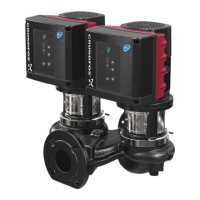17
English (US)
Open systems where the liquid level is below the pump inlet
The suction pipe and the pump must be filled with liquid and
vented before you start the pump.
1. Close the discharge isolating valve and open the isolating
valve in the suction pipe.
2. Loosen the air vent screw. See fig. 26.
3. Remove the plug from one of the pump flanges, depending on
the pump location.
4. Pour liquid through the priming port until the suction pipe and
the pump are filled with liquid.
5. Replace the plug and tighten securely.
6. Tighten the air vent screw.
The suction pipe can to some extent be filled with liquid and
vented before it is connected to the pump. You can also install a
priming device before the pump.
Fig. 26 Position of air vent screw
10.3 Starting
1. Before starting the pump, completely open the isolating valve
on the suction side of the pump and leave the discharge
isolating valve almost closed.
2. Start the pump. See section 11. User interfaces.
3. Vent the pump during starting by loosening the air vent screw
in the motor stool until a steady stream of liquid runs out of the
vent hole. See fig. 26.
4. When the pipe system has been filled with liquid, slowly open
the discharge isolating valve until it is completely open.
10.4 Shaft seal run-in
The seal faces are lubricated by the pumped liquid, meaning that
there may be a certain amount of leakage from the shaft seal.
When the pump is started up for the first time, or when a new shaft
seal is installed, a certain run-in period is required before the
leakage is reduced to an acceptable level. The time required for
this depends on the operating conditions, i.e. every time the
operating conditions change, a new run-in period will be started.
Under normal conditions, the leaking liquid will evaporate. As a
result, no leakage will be detected.
However, liquids such as kerosene will not evaporate. The leakage
may therefore be seen as a shaft seal failure.
11. User interfaces
Pump settings can be made by means of the following user
interfaces:
Control panels
• Standard control panel.
See section 12. Standard control panel.
• Advanced control panel.
See section 13. Advanced control panel.
Remote controls
• Grundfos GO Remote.
See section 14. Grundfos GO Remote.
If you switch-off the power supply to the pump, the settings will be
stored.
Factory settings
TPE2 (D) pumps have been factory-set to constant-curve control
mode. See section 12.1.2 Pump in constant-curve control mode.
The setpoint value corresponds to 100 %, of maximum pump
performance. See data booklet or WebCAPS.
TPE3 (D) pumps have been factory-set to AUTO
ADAPT
control
mode. See section 15.4.1 AUTOADAPT.
TM05 7922 1613
Warning
Pay attention to the direction of the vent hole,
and make sure that the escaping hot or cold
liquid does not cause injury to persons or
damage to the equipment.
Warning
The product may be so hot that only the buttons
must be touched to avoid burns.

